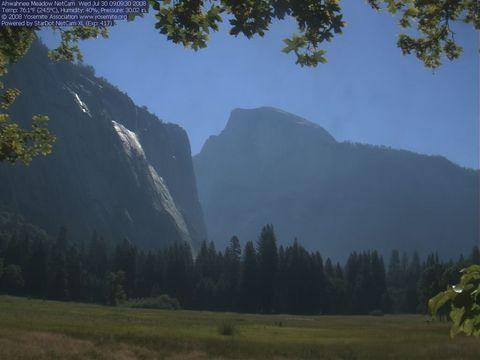Firefighters are continuing to struggle with the so-called Telegraph Fire that's burning to the west of Yosemite National Park. While on Monday the fire was estimated to be burning 25-30 miles west of the park, it now is reported to be about 15 miles from the park's western boundary.
Inside the park, things are about as normal as can be expected. All roads, trails and services are open in Yosemite, though the air is a tad on the smoky side, as the accompanying photo, taken this morning a little after 9 a.m. local time, shows.
Also, to allow for safe fire operations, there are ongoing partial and complete closures of Highway 140, which runs west from the park's Arch Rock Entrance to El Portal, Incline, Midpines and Mariposa. Highway 140 is currently closed outside of Yosemite, from 1.4 miles west of Briceburg to 6.3 miles west of the Yosemite National Park boundary. Call the Caltrans number (1-800/427-7623) for most updated road information.
The fire, which is burning in mixed scrub and forest, grew by more than 2,400 acres in the last 24 hours and currently is estimated at larger than 32,000 acres. Just 20 percent of the blaze has been contained. The fire, which is being fought by nearly 4,000 personnel, has run up near $14 million in costs. It reportedly was sparked by someone target shooting on private property.
For a look at the aerial battle taking place, check out the following video. Captured by Doug Michael of Mariposa, California, it depicts one of the helicopters refilling its hold with fire retardant to be spit out on the flames. It's not entirely unlike a hummingbird sucking up nectar from a flower.




Comments
The Telegraph Fire started on Friday afternoon. By about 6pm on Saturday, the smoke was pouring over the Sierra Crest into the Hoover Wilderness, 50 trail-miles northeast of Tuolumne Meadows. It looked like a storm coming in, except for the orange sunlight. By 10pm, I was awakened in my backcountry campsite, just outside of the northeast boundary of the park, by smoky air that made it difficult to breath, or to sleep.
Late on Monday (July 28) I drove through Yosemite Valley. I couldn't see the top of El Cap from Tunnel View. I could barely make out the outline of Half Dome from the Camp Curry parking lot. It appeared that the entire DNC concession operation was running off of diesel generators (which didn't help the air quality any). We drove back to the Bay Are via. Highway 120 rather than risk being turned around by a road closure on 140.
__________
The WildeBeat "The audio journal about getting into the wilderness"
10-minute weekly documentaries to help you appreciate our wild public lands.
A 501c3 non-profit project of Earth Island Institute.